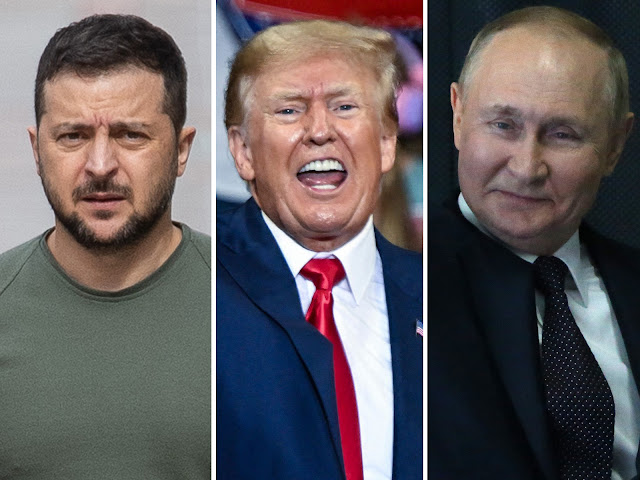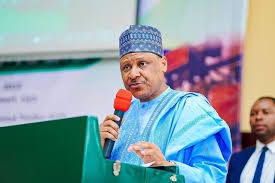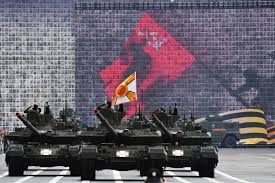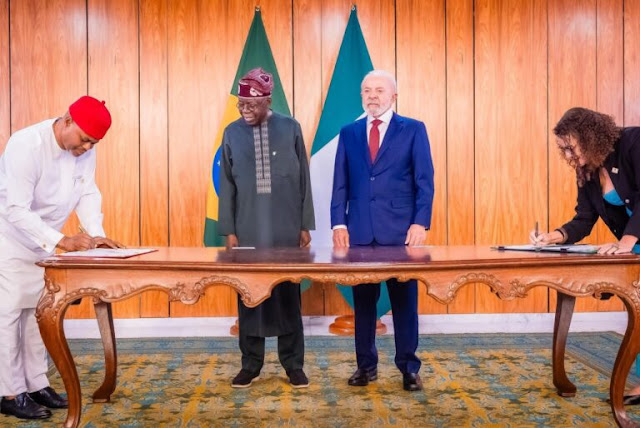Washington, D.C. – U.S. President Donald Trump reaffirmed America’s commitment to supporting Ukraine in its ongoing conflict with Russia but emphasized that specific security guarantees, a critical component for ending the war, have not yet been finalized. Speaking to reporters in the Oval Office on August 25, 2025, Trump highlighted the complexity of negotiations, noting that security guarantees remain a significant obstacle to achieving peace. He also revealed that during his August 15 summit with Russian President Vladimir Putin in Anchorage, Alaska, the two leaders discussed the possibility of reducing their countries’ nuclear arsenals once the Ukraine crisis is resolved. “We would like to denuclearize. It’s too much power, and we talked about that also. That’s part of it, but we have to get the war over with,” Trump said. When pressed on why Putin appears reluctant to meet Ukrainian President Volodymyr Zelensky, Trump offered a candid response: “Because he doesn’t like him.” The remarks, made in the context of ongoing diplomatic efforts, underscore the delicate balance of U.S. foreign policy as it navigates support for Ukraine, nuclear arms control, and the pursuit of a resolution to one of Europe’s deadliest conflicts since World War II.
The Alaska Summit: A High-Stakes Meeting
The August 15, 2025, summit between Trump and Putin, held at Joint Base Elmendorf-Richardson in Anchorage, marked a significant moment in U.S.-Russia relations. Dubbed the “Alaska 2025” or “Trump-Putin Summit,” it was the first U.S.-hosted meeting between the leaders of the two nations since 2007, when Russian President Vladimir Putin met then-President George W. Bush in Maine. The primary focus was the Russia-Ukraine war, which began with Russia’s full-scale invasion in February 2022 and has since claimed tens of thousands of lives, displaced millions, and reshaped global geopolitics. Trump, who campaigned in 2024 on a promise to end the war swiftly, approached the summit with ambitious goals, including securing a ceasefire and laying the groundwork for broader peace negotiations.
While the summit did not produce a ceasefire, it yielded discussions on critical issues, including potential security guarantees for Ukraine and nuclear arms reduction. Trump’s revelation that he and Putin explored “denuclearization” reflects a broader ambition to address global security threats, though he emphasized that resolving the Ukraine conflict remains a prerequisite. “We didn’t get there,” Trump admitted, referring to the lack of progress on a ceasefire, a sentiment echoed by analysts who noted that Putin regained international stature through the summit, while concrete outcomes remained elusive.
The discussion on nuclear arsenals is particularly significant given the strained history of U.S.-Russia arms control agreements. Russia suspended its participation in the New START treaty in February 2023, citing U.S. support for Ukraine as a barrier to negotiations. Moscow has since insisted that any new arms control talks include the nuclear arsenals of France and the United Kingdom, a condition that complicates prospects for bilateral agreements. Trump’s comments suggest a willingness to revisit these discussions, potentially involving China, but only after progress on Ukraine.
U.S. Support for Ukraine: A Reaffirmed Commitment
Trump’s reaffirmation of U.S. support for Ukraine comes amid a complex and evolving U.S. foreign policy landscape. During his first term (2017–2021), Trump faced criticism for his handling of Ukraine, particularly following a 2019 impeachment inquiry centered on allegations that he pressured Zelensky to investigate political rivals in exchange for military aid. His return to the presidency in January 2025 has been marked by a renewed focus on resolving the Russia-Ukraine war, though his approach—emphasizing rapid peace deals over prolonged military support—has sparked debate among policymakers and analysts.
Since Russia’s invasion, the U.S. has provided over $50 billion in military, financial, and humanitarian aid to Ukraine, including $12.1 billion in security assistance in fiscal year 2023 alone. This support, channeled through initiatives like the Ukraine Security Assistance Initiative (USAI) and Foreign Military Financing (FMF), has included counter-mortar radars, secure radios, vehicles, and medical supplies, bolstering Ukraine’s defense against Russian aggression. Trump’s statement on August 25 signals continuity in this commitment, but his emphasis on unresolved security guarantees highlights the challenges of translating support into a sustainable resolution.
Security guarantees are a cornerstone of Ukraine’s demands in peace negotiations. Kyiv seeks assurances that it can deter future Russian aggression, potentially through a NATO-like collective defense mechanism. Italian Prime Minister Giorgia Meloni has proposed a model inspired by NATO’s Article 5, where an attack on Ukraine would trigger a collective response from its partners, without requiring full NATO membership. However, Russia has rejected the deployment of NATO troops in Ukraine as part of any deal, complicating negotiations. Trump’s administration has ruled out deploying U.S. troops on the ground but left open the possibility of other forms of support, such as air defense systems or financial backing for weapons purchases.
The Obstacle of Security Guarantees
Trump’s acknowledgment that security guarantees remain a “major obstacle” underscores the complexity of ending the war. Ukraine’s President Zelensky has consistently advocated for “robust and credible” guarantees, viewing them as essential to preventing further Russian incursions. During a White House meeting on August 18, 2025, with Trump and European leaders, including French President Emmanuel Macron and German Chancellor Friedrich Merz, Zelensky hailed the U.S. commitment as a “major step forward,” noting that guarantees would be formalized within days. However, the lack of specificity in these discussions has left Kyiv seeking clarity.
The concept of security guarantees is fraught with challenges. For Ukraine, guarantees must be binding and enforceable, potentially involving military commitments from Western allies. However, Russia’s insistence on having a veto over Ukraine’s defense arrangements, as articulated by Foreign Minister Sergei Lavrov, poses a significant hurdle. Lavrov’s demand that Russia be included in any security framework effectively grants Moscow influence over Ukraine’s sovereignty, a condition Kyiv has rejected outright.
European leaders have proposed alternatives, such as a “coalition of the willing” led by countries like Britain, France, and Germany, to provide peacekeeping forces or financial support. British Prime Minister Keir Starmer has discussed assembling such a force, while Canada’s Prime Minister Mark Carney has pledged additional military and economic aid to complement U.S. efforts. These proposals aim to balance Ukraine’s need for security with Russia’s demand for assurances that NATO will not expand further eastward, a key point of contention since the war began.
Trump’s approach, as articulated in the Oval Office, prioritizes a peace deal over a prolonged ceasefire, a stance that aligns with German Chancellor Merz’s view that a quick resolution may be more valuable than a temporary halt in fighting. However, Zelensky has emphasized that Russia, as the aggressor, must take responsibility for ending the war, rejecting territorial concessions such as ceding the Donbas region, which Putin demanded during the Alaska summit. The tension between these positions highlights the diplomatic tightrope Trump must walk to broker a deal.
Nuclear Arms Reduction: An Ambitious Proposal
Trump’s revelation that he and Putin discussed nuclear arms reduction during their Alaska meeting introduces a surprising dimension to the summit. The U.S. and Russia possess the world’s largest nuclear arsenals, with approximately 5,000 and 6,000 warheads, respectively, according to the Arms Control Association. The New START treaty, set to expire in 2026, limits each country to 1,550 deployed strategic warheads, but Russia’s suspension of the treaty has raised concerns about a new arms race.
Trump’s interest in “denuclearization” reflects a long-standing goal of reducing global nuclear risks, though his comments suggest a pragmatic approach tied to resolving the Ukraine crisis. “It’s too much power,” he said, referring to the destructive capacity of nuclear arsenals. The inclusion of China in future talks, as Trump proposed, acknowledges Beijing’s growing nuclear capabilities, estimated at 500 warheads in 2025, with projections of reaching 1,000 by 2030. China’s Foreign Ministry has reiterated its stance that the U.S. and Russia must make “drastic and substantive cuts” to their arsenals before other nations join disarmament talks, complicating the path forward.
The linkage between Ukraine and nuclear arms control is a strategic move by Trump, who has positioned himself as a mediator capable of addressing multiple global challenges simultaneously. However, analysts caution that nuclear negotiations are unlikely to progress without a resolution to the Ukraine conflict, given Russia’s insistence that U.S. support for Kyiv precludes arms control discussions. Dmitry Peskov, Putin’s spokesman, has emphasized Moscow’s demand to include French and British arsenals in any talks, a condition that could stall progress.
Putin’s Reluctance to Meet Zelensky
Trump’s blunt assessment that Putin is unwilling to meet Zelensky “because he doesn’t like him” offers a rare glimpse into the personal dynamics shaping high-stakes diplomacy. The strained relationship between Putin and Zelensky is well-documented, rooted in Russia’s annexation of Crimea in 2014 and the ongoing war in eastern Ukraine. Putin’s demands, including Ukraine’s cession of the Donbas region and neutrality on NATO membership, have been consistently rejected by Zelensky, who views territorial integrity and Western alignment as non-negotiable.
Trump’s comment, while candid, risks oversimplifying a complex geopolitical standoff. Putin’s reluctance may stem from strategic calculations rather than personal animus. A direct meeting with Zelensky could legitimize Ukraine’s position and signal Russian concessions, which Putin may be unwilling to make without significant leverage. The Kremlin’s rejection of NATO troop deployments in Ukraine as part of any peace deal further complicates the prospect of a bilateral summit.
Trump has proposed facilitating a meeting between Putin and Zelensky, followed by a trilateral summit including himself, to advance negotiations. White House Press Secretary Karoline Leavitt confirmed on August 20 that plans for such a meeting are “underway,” though Russia has not officially agreed. The proposal reflects Trump’s preference for high-profile diplomacy, a hallmark of his first term, but its success hinges on overcoming Putin’s reservations and aligning the interests of Ukraine, Russia, and Western allies.
Reactions and Public Sentiment
The developments have sparked varied reactions among stakeholders and the public. On X, posts reflect a polarized sentiment. Supporters of Trump’s approach, such as @AmericaFirst2025, praise his efforts to broker peace and reduce nuclear risks, writing, “Trump’s bringing Putin to the table—nobody else could do this.” Critics, like @GlobalWatchdog, argue that his focus on rapid deals risks pressuring Ukraine into unfavorable concessions, noting, “Zelensky’s fighting for survival, not just a photo-op.” These reactions highlight the high stakes of Trump’s diplomacy, with opinions divided between those who view him as a bold peacemaker and those who fear he prioritizes spectacle over substance.
European leaders have expressed cautious optimism. Canadian Prime Minister Mark Carney praised Trump for “creating the opportunity to end Russia’s illegal war,” emphasizing the need for “robust and credible security guarantees.” NATO Secretary General Mark Rutte noted that a security guarantee resembling Article 5 could be offered in lieu of NATO membership, though he acknowledged the lack of clarity in Trump’s plans. Zelensky, while welcoming U.S. support, has pushed for concrete commitments, reportedly offering to purchase $90 billion in U.S. weapons as part of a security package.
Russia’s response has been less enthusiastic. The Kremlin’s rejection of NATO involvement and insistence on territorial concessions suggest that Putin views negotiations as a means to secure strategic gains. The Financial Times reported that Putin’s participation in the Alaska summit was a diplomatic victory, enhancing his global standing without committing to concrete concessions.
Historical Context: U.S.-Russia-Ukraine Relations
The current negotiations must be understood within the historical context of U.S.-Russia-Ukraine relations. The U.S. has long supported Ukraine’s sovereignty, particularly since Russia’s annexation of Crimea in 2014 and the outbreak of conflict in Donbas. Under President Barack Obama, the U.S. provided non-lethal aid, while President Joe Biden escalated support with lethal weapons and financial aid following the 2022 invasion. Trump’s first term saw a mixed approach, with military aid to Ukraine continuing but overshadowed by the 2019 impeachment controversy.
The nuclear dimension adds further complexity. The U.S. and Russia have a history of arms control agreements, from the Strategic Arms Limitation Talks (SALT) in the 1970s to New START in 2010. Russia’s suspension of New START and its demands to include other nations’ arsenals reflect a shift toward a multipolar approach to arms control, challenging U.S. leadership. Trump’s willingness to engage on this issue, as seen in his discussions with Putin, signals a pragmatic recognition of these dynamics, though the path to agreement remains uncertain.
Broader Implications: Peace, Power, and Global Stability
Trump’s reaffirmation of support for Ukraine, coupled with his nuclear talks with Putin, has far-reaching implications for global stability. A resolution to the Russia-Ukraine war could reshape Europe’s security architecture, potentially stabilizing energy markets, reducing refugee flows, and easing tensions between NATO and Russia. However, the absence of specific security guarantees risks prolonging the conflict, as Ukraine remains wary of Russian intentions and Western commitments.
The nuclear discussions, while preliminary, could pave the way for a new era of arms control, particularly if China is included. However, the linkage to Ukraine complicates progress, as Russia’s strategic priorities remain tied to its regional ambitions. Trump’s approach—combining support for Ukraine with direct engagement with Putin—reflects a high-risk, high-reward strategy that could either yield a historic breakthrough or deepen mistrust among allies.
For Ukraine, the stakes are existential. Zelensky’s rejection of territorial concessions and insistence on NATO-like guarantees underscore Kyiv’s determination to secure its sovereignty. The U.S.’s role as a guarantor, whether through weapons, funding, or diplomatic leverage, will be critical in shaping the outcome. Trump’s reluctance to deploy U.S. troops, as confirmed by Press Secretary Leavitt, suggests a focus on indirect support, potentially straining relations with European allies who seek a more robust Western presence.
Challenges Ahead
Several challenges loom over Trump’s diplomatic efforts. First, the personal animosity between Putin and Zelensky, as noted by Trump, could derail bilateral talks. Second, Russia’s insistence on a veto over Ukraine’s security arrangements conflicts with Kyiv’s demand for autonomy, creating a diplomatic impasse. Third, the nuclear talks, while ambitious, face resistance from Russia’s demand to include other nations and China’s reluctance to engage without significant U.S. concessions.
Domestically, Trump faces pressure to balance his “America First” agenda with international commitments. His base, wary of prolonged foreign entanglements, may resist extensive support for Ukraine, while critics in Congress argue that his focus on rapid deals risks undermining U.S. credibility. The revocation of security clearances for 37 intelligence officials, reported on August 19, 2025, suggests internal efforts to consolidate control over foreign policy, potentially complicating coordination with allies.
Conclusion
President Trump’s reaffirmation of U.S. support for Ukraine, coupled with his discussions on nuclear arms reduction and the challenges of security guarantees, reflects a multifaceted approach to one of the world’s most pressing conflicts. The August 15 Alaska summit with Putin, while falling short of a ceasefire, opened the door to broader conversations about global security, from Ukraine’s defense to nuclear disarmament. However, the absence of concrete security guarantees and Putin’s reluctance to engage directly with Zelensky highlight the difficulties ahead.
As diplomatic efforts continue, the world watches closely. Trump’s strategy—leveraging personal diplomacy, U.S. military aid, and the prospect of nuclear talks—could reshape the geopolitical landscape, but it requires navigating a complex web of interests and egos. For Ukraine, the promise of U.S. support offers hope, but the path to peace remains fraught with uncertainty. For those following the developments, updates from the White House, Ukraine’s government, and international media will provide critical insights into the evolving situation.






